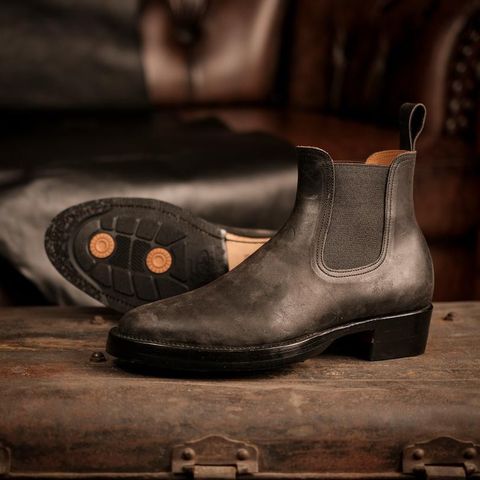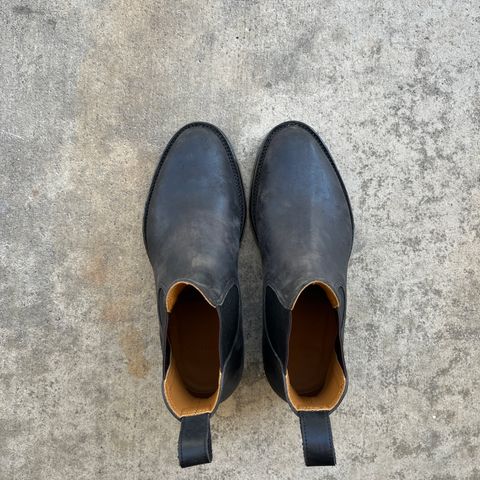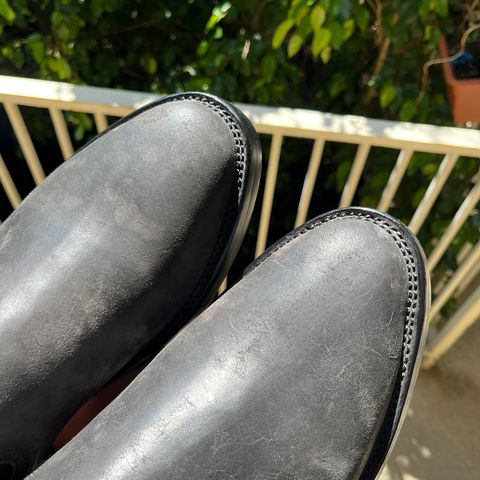About
Maryam Black Waxed Reverse Horsebutt is a premium leather produced by Conceria Maryam, a traditional Tuscan tannery in Santa Croce sull'Arno, Italy. This distinctive leather features the flesh side finished as the exterior surface, creating a unique rustic appearance prized by high-end bootmakers. The black waxed finish combines vegetable tanning with oil, wax, and resin treatments to produce a leather with exceptional aging characteristics and patina development.
About
Maryam Black Waxed Reverse Horsebutt is a premium leather produced by Conceria Maryam, a traditional Tuscan tannery in Santa Croce sull'Arno, Italy. This distinctive leather features the flesh side finished as the exterior surface, creating a unique rustic appearance prized by high-end bootmakers. The black waxed finish combines vegetable tanning with oil, wax, and resin treatments to produce a leather with exceptional aging characteristics and patina development.
As part of Maryam's reverse horsebutt collection, this leather represents a specialized approach to working with equine hides that don't meet the size and quality requirements for shell cordovan production. The result is a dense, fibrous leather with shell cordovan-like properties at approximately one-third the cost.
Characteristics
Physical Properties
Maryam Black Waxed Reverse Horsebutt exhibits specific technical characteristics that distinguish it from other leather types:
Thickness: 5oz (2.0mm) ± 0.3mm
Tannage: 100% vegetable tanned using natural tannins from trees
Grain Structure: Full grain with flesh side as exterior surface
Firmness: Medium density (6/10 scale)
Finish: Full aniline with TPR (oil/wax/resin) treatment
Dye Penetration: Complete through-dye coverage
Burnishability: Excellent burnishing properties
The reverse construction means the flesh side, normally hidden inside products, becomes the visible exterior surface. This creates a more textured, organic appearance compared to traditional grain-side-out leathers.
Color and Finish
The black waxed finish provides initial rich luster while maintaining the leather's ability to develop patina over time. The TPR treatment creates a shell cordovan-esque appearance with protective and aesthetic benefits. The black dye penetrates completely through the leather thickness, ensuring color consistency and durability.
Production Process
Vegetable Tanning
Conceria Maryam employs traditional Tuscan vegetable tanning methods passed down through centuries. The process uses natural tannins extracted from trees, including mimosa and quebracho, combined with modern technology to ensure consistency and quality.
The tannery processes only waste leathers from the food industry, emphasizing sustainability and ethical sourcing. All leather manufacturing occurs entirely within Maryam's facility, maintaining quality control from raw hide to finished product.
Source Material
The horsebutt hides used for reverse construction come from equine sources that don't meet the specific size and quality criteria required for shell cordovan production. Despite this secondary classification, these hides retain the dense fibrous structure characteristic of the horse's rump area.
Many hides include small areas of actual shell cordovan, known as "bone" in Italy, which can be utilized within the larger hide structure. This provides shell cordovan-like characteristics in select portions of the leather.
Waxed Treatment
The TPR finish involves treating the vegetable-tanned leather with a carefully balanced mixture of oils, waxes, and resins. This treatment serves multiple purposes:
Creates immediate rich luster and depth
Provides water resistance and protection
Enhances the leather's natural patina-developing properties
Maintains flexibility while preserving structure
Aging and Patina Development
Teacore Characteristics
Black waxed reverse horsebutt exhibits teacore properties, where brown undertones emerge through wear and stretching. This creates dramatic visual evolution over time, with heavily worn areas showing more brown than black after extended use.
The vegetable tanning process makes this leather particularly receptive to patina development, with visible changes beginning within months of regular use and significant character development apparent after one year.
Wax Bloom
A distinctive characteristic of waxed leather is the development of "bloom" - a whitish surface layer that appears as oils and waxes migrate to the surface over time. This natural phenomenon can be easily removed with brushing and indicates the leather's active aging process.
The bloom pattern varies based on environmental conditions, use patterns, and storage conditions, creating unique visual markers of each item's individual history.
Long-term Evolution
The combination of vegetable tanning and waxed treatment creates complex aging patterns. The leather develops:
Increased luster and depth over time
Softening while maintaining structural integrity
Unique crease and wear patterns reflecting use
Enhanced water resistance through natural oil development
Applications
Footwear
High-end bootmakers particularly value Maryam Black Waxed Reverse Horsebutt for its unique aesthetic and durability. The reverse construction provides:
Distinctive rustic appearance
Excellent durability for work and casual boots
Shell cordovan-like rolling rather than creasing
Superior aging characteristics
Leather Goods
The dense, fibrous nature makes this leather suitable for:
Premium wallets and small leather goods
Belts requiring durability and character
Bags benefiting from unique texture
Accessories where patina development enhances appeal
Care and Maintenance
Regular Maintenance
Black waxed reverse horsebutt requires minimal intervention to develop optimal patina:
Light brushing to remove wax bloom as needed
Occasional conditioning with appropriate products
Protection from extreme moisture and heat
Natural aging without excessive treatment
Restoration
The leather's robust construction allows for restoration when necessary:
Professional reconditioning can refresh appearance
Wax bloom removal restores original luster
Vegetable tanning allows for re-dyeing if needed
Dense fiber structure resists permanent damage
Comparison to Other Leathers
Versus Shell Cordovan
While sharing similar source material, Maryam Black Waxed Reverse Horsebutt differs from shell cordovan in:
Cost: Approximately one-third the price of shell cordovan
Surface: Flesh side exterior vs. grain side for cordovan
Availability: More accessible than limited shell cordovan production
Character: More rustic appearance vs. cordovan's refined finish
Versus Standard Horsebutt
Compared to grain-side-out horsebutt leathers:
Texture: More organic, less refined appearance
Aging: Different patina patterns due to flesh-side exposure
Applications: Preferred for rustic, heritage-style products
Processing: Requires specialized finishing techniques
Historical Context
Maryam's production of reverse horsebutt represents the evolution of traditional leather-making to meet contemporary market demands. By utilizing portions of horse hides previously considered secondary, the tannery creates premium products while minimizing waste.
The technique reflects broader trends in heritage craftsmanship, where traditional methods combine with modern understanding to create distinctive materials for discerning makers and consumers.








































